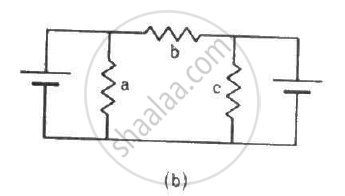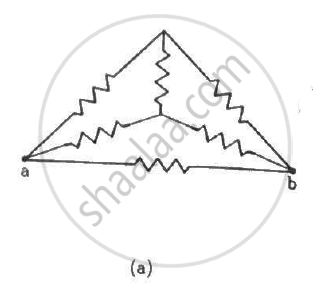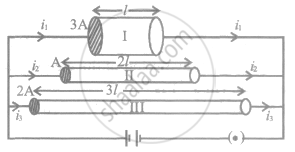Advertisements
Advertisements
प्रश्न
Two voltameters, one with a solution of silver salt and the other with a trivalent-metal salt, are connected in series and a current of 2 A is maintained for 1.50 hours. It is found that 1.00 g of the trivalent metal is deposited. (a) What is the atomic weight of the trivalent metal?
(b) How much silver is deposited during this period? Atomic weight of silver is 107.9 g mol−1.
उत्तर
Given:-
Mass of salt deposited, m = 1 g
Current, i = 2 A
Time, t = 1.5 hours = 5400 s
For the trivalent metal salt:-
Equivalent mass = \[\frac{1}{3}\] Atomic weight
The E.C.E of the salt,
\[Z = \frac{\text{Equivalent mass}}{96500} = \frac{\text{Atomic weight}}{3 \times 96500}\]
(a) Using the formula, m = Zit, we get:-
\[1 \times {10}^{- 3} = \frac{\text{Atomic weight}}{3 \times 96500} \times 2 \times 5400\]
\[ \Rightarrow\text{Atomic weight }= \frac{3 \times 96500 \times {10}^{- 3}}{2 \times 5400} = 26 . 8 \times {10}^{- 3}\text{ kg/mole}\]
\[ \Rightarrow \text{Atomic weight }= 26 . 8\text{ g/mole}\]
(b) Using the relation between equivalent mass and mass deposited on plates, we get:-
\[\frac{E_1}{E_2} = \frac{m_1}{m_2}\]
\[ \Rightarrow \frac{26 . 8}{3 \times 107 . 9} = \frac{1}{m_2}\]
\[ \Rightarrow m_2 = 12 . 1 g\]
APPEARS IN
संबंधित प्रश्न
Suppose you have three resistors of 20 Ω, 50 Ω and 100 Ω. What minimum and maximum resistance can you obtain from these resistors?
If the reading of the ammeter, A1 in the following figure is 2.4 A, what will be the readings of ammeters A2 and A3? Neglect the resistances of the ammeters.

An ideal battery sends a current of 5 A in a resistor. When another resistor of 10 Ω is connected in parallel, the current through the battery is increased to 6 A. Find the resistance of the first resistor.
A wire of resistance 15.0 Ω is bent to form a regular hexagon ABCDEFA. Find the equivalent resistance of the loop between the points (a) A and B (b) A and C and (c) Aand D.
Each of the resistors shown in the figure has a resistance of 10 Ω and each of the batteries has an emf of 10 V. Find the currents flowing through the resistors a and bin the two circuits.


Find the equivalent resistance of the circuits shown in the figure between the points a and b. Each resistor has resistance r.


The emf ε and the internal resistance r of the battery, shown in the figure, are 4.3 V and 1.0 Ω respectively. The external resistance R is 50 Ω. The resistances of the ammeter and voltmeter are 2.0 Ω and 200 Ω respectively. (a) Find the readings of the two meters. (b) The switch is thrown to the other side. What will be the readings of the two meters now?

A voltmeter coil has resistance 50.0 Ω and a resistor of 1.15 kΩ is connected in series. It can read potential differences up to 12 volts. If this same coil is used to construct an ammeter that can measure currents up to 2.0 A, what should be the resistance of the shunt used?
Two resistors R1= 60 Ω and R2 = 90Ω are connected in parallel. If electric power consumed by the resistor R1 is15 W, calculate the power consumed by the resistor R2.
How much resistance should be connected to 15 Ω resistor shown in the circuit in figure below so that the points M and N are at the same potential:

A current of 2 A flows in conductors as shown. The potential difference VA- VB will be ________.

To get maximum current in a resistance of 3 ohms, one can use n rows of m cells (connected in series) connected in parallel. If the total number of cells is 24 and the internal resistance of a cell is 0.5 ohms then ______.
If two resistors of resistances R1 = (4 ± 0.5) Ω and R2 = (16 ± 0.5) Ω are connected in series. The eqivalent resistance with the limits of percentage error is ______.
The figure shows three conductors I, II and III of same material, different lengths l, 2l and 3l and of different areas of cross-sections 3A, A and 2A respectively. Arrange them in the increasing order of current drawn from the battery.

Two electric lamps of each 40 watt are connected in series. The power consumed by the combination will be
The effective resistance of a parallel connection that consists of four wires of equal length, equal area of cross-section and same material is 0.25 Ω. What will be the effective resistance if they are connected in series?
An electric cable of copper has just one wire of radius 9 mm. Its resistance is 14Ω. If this single copper wire of the cable is replaced by seven identical well insulated copper wires each of radius 3 mm connected in parallel, then the new resistance of the combination will be:
